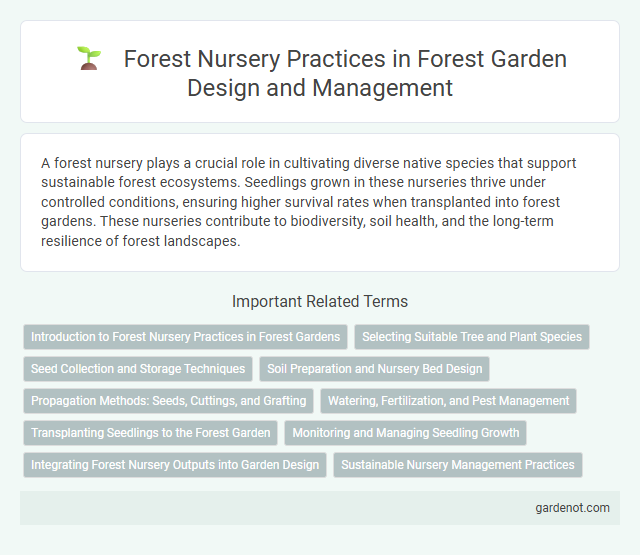A forest nursery plays a crucial role in cultivating diverse native species that support sustainable forest ecosystems. Seedlings grown in these nurseries thrive under controlled conditions, ensuring higher survival rates when transplanted into forest gardens. These nurseries contribute to biodiversity, soil health, and the long-term resilience of forest landscapes.
Introduction to Forest Nursery Practices in Forest Gardens
Forest nursery practices in forest gardens emphasize propagating diverse native tree species to establish resilient, multifunctional ecosystems. Techniques include seed selection, germination control, and nurturing saplings in shaded environments that mimic natural forest conditions, promoting robust growth. These practices support biodiversity conservation and enhance the sustainability of forest gardens by providing healthy, well-adapted plants for planting.
Selecting Suitable Tree and Plant Species
Selecting suitable tree and plant species for a forest nursery involves prioritizing native varieties that thrive in local climate and soil conditions to ensure optimal growth and biodiversity. Emphasizing species with high ecological value, such as nitrogen-fixing trees and wildlife-supporting plants, enhances the sustainability and resilience of the forest garden ecosystem. Careful consideration of growth habits, shade tolerance, and water requirements supports balanced canopy development and efficient resource use within the nursery.
Seed Collection and Storage Techniques
Seed collection for forest nurseries requires selecting mature, healthy seeds from diverse tree species to ensure genetic diversity and robust growth. Proper storage techniques, including drying seeds to optimal moisture levels and maintaining low temperatures, preserve seed viability and germination rates over extended periods. Utilizing airtight containers and controlling humidity prevent fungal contamination and seed deterioration, crucial for successful forest garden establishment.
Soil Preparation and Nursery Bed Design
Forest nursery soil preparation involves thorough loosening and enrichment with organic compost to enhance nutrient retention and drainage. Nursery beds are designed with raised or flat layouts, incorporating adequate spacing and mulching to prevent erosion and maintain consistent moisture levels. Proper soil pH adjustment and texture optimization ensure optimal seedling growth and root development in forest nursery environments.
Propagation Methods: Seeds, Cuttings, and Grafting
Forest nurseries employ propagation methods such as seeds, cuttings, and grafting to cultivate diverse plant species for forest gardens. Seed propagation supports genetic diversity and resilience, while cuttings provide clones of desirable traits for uniform growth and faster establishment. Grafting combines rootstock and scion to enhance disease resistance, vigor, and fruit production in selected tree species within the forest garden ecosystem.
Watering, Fertilization, and Pest Management
Forest nurseries require precise watering schedules to maintain optimal soil moisture for seedling growth, using drip irrigation to conserve water and reduce disease risks. Fertilization strategies focus on organic compost and biofertilizers that enhance soil fertility and support beneficial microbial activity. Integrated pest management employs natural predators and plant-based repellents to control pests while minimizing chemical usage and promoting ecosystem health.
Transplanting Seedlings to the Forest Garden
Transplanting seedlings from a forest nursery to the forest garden requires careful timing and soil preparation to ensure healthy growth. Seedlings should be hardened off by gradually exposing them to outdoor conditions before transplanting to reduce transplant shock. Proper spacing, mulching, and consistent watering in the initial weeks after planting promote strong root establishment and long-term survival in the forest garden ecosystem.
Monitoring and Managing Seedling Growth
Monitoring and managing seedling growth in a forest nursery involves regular assessment of soil moisture, nutrient levels, and light exposure to ensure optimal development. Precise control of irrigation and fertilization schedules helps prevent stress and supports robust root and shoot formation. Implementing pest and disease surveillance combined with timely interventions reduces mortality rates and promotes healthy, vigorous seedlings ready for transplantation.
Integrating Forest Nursery Outputs into Garden Design
Forest nursery outputs provide diverse saplings and seedlings essential for establishing layered forest gardens. Incorporating native tree species and understory plants from these nurseries enhances biodiversity and soil health through natural nutrient cycling. Strategic placement of nursery-grown plants supports microclimates, pest resistance, and long-term ecosystem resilience within the garden design.
Sustainable Nursery Management Practices
Forest nurseries implementing sustainable nursery management practices emphasize water conservation techniques such as drip irrigation and rainwater harvesting, reducing water waste significantly. They use organic soil amendments and integrated pest management to maintain soil health and minimize chemical inputs, promoting biodiversity and long-term ecosystem stability. Renewable energy sources like solar power are increasingly adopted to lower the carbon footprint of nursery operations while supporting the growth of native and climate-resilient tree species for forest garden restoration.
Forest nursery Infographic

 gardenot.com
gardenot.com